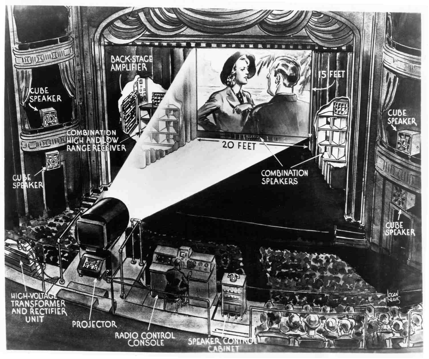Compression
Most people in the digital cinema business today agree that feature films will have to be compressed in some way to make transporting and storing them economical. In addition, compression technology has evolved to the point where there is little or no penalty in terms of visual quality to be paid by compressing a movie. There are several basic technologies being seriously considered for digital cinema applications, including:
MPEG2 is an established worldwide standard that supports 4:2:2 video formats all the way up to HDTV. The standard is very flexible, well understood by legions of engineers around the world, and supported by a large number of relatively inexpensive chipsets, software and other off the shelf technology. There is also a worldwide organization that supports and maintains the standard. There was been some resistance to the use of MPEG2 due to certain dynamic range, resolution and colorimetry limitations; MPEG2 may also be too closely linked with the idea of “television” to be accepted as a standard for true “cinema quality” applications.
Wavelet compression is often discussed in digital cinema circles. Wavelet systems are currently proprietary and have been developed by a number of different companies.
One company has developed a proprietary variant on MPEG2 that utilizes adaptively scaled macroblocks. This may improve compression efficiency and therefore allow better looking pictures to be reproduced at lower bitrates than standard MPEG2 algorithms.
Other compression schemes are being discussed as well, including MPEG4, Motion-JPEG and various lossless systems.
Encryption and Security
Piracy is, of course, a major concern for the studios and other organizations that may supply content to digital cinema exhibitors. A successful system must protect the assets entrusted to it and do everything possible to defeat the pirates. The system must make it extremely difficult to directly copy an unencrypted file of a movie and ideally must also make it difficult or at least very inconvenient to use a camcorder to capture a movie off the screen.
It’s important to understand the difference between encryption and security. Think of encryption as the method used to scramble a file so that it becomes unreadable without to correct key (or keys) and decryption algorithm. Security is how you handle the files and the equipment necessary to store, encrypt, decrypt and transmit the files so as to prevent theft. For example, a perfect encryption scheme is completely valueless if a worker in a theater knows a password that allows him to decrypt and copy or project a movie without the proper authorization. A well thought-out security system must protect the hardware and wiring in a theater with tamperproof housings, protect the passwords and keys required to decrypt a movie so that only authorized personnel have access to them and make it extremely difficult even for authorized people to decrypt, copy or project a movie except as authorized by the content owners.
Part of a good security model will involve “watermarking”, which will imprint a time and location stamp in each showing of a movie. This watermark must be invisible to the moviegoer and still be capable of being decoded and displayed by the content owner should a pirated copy of a movie be found. The watermark will have to be capable of surviving multiple digital and/or analog copy generations and not interfere with the normal scheduled screening of the movies.
There are a number of very well established encryption and security systems in daily use all over the world by banks, governments and other big institutions. These systems guard our cash and our investments and allow us to move money around in a reasonably convenient, easy to use and extremely secure way. Digital cinema should build on these established and well-understood technologies and systems.
A number of companies are now publicly suggesting different encryption schemes and security models for digital cinema. The studios’ lawyers are seriously discussing these.
